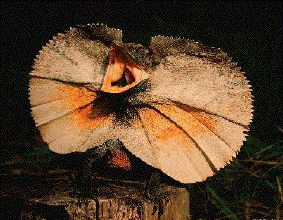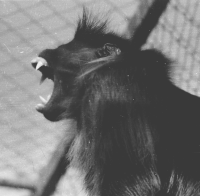La présence éventuelle d'une publicité ci-dessus est insérée par le routeur du "mailing-list" indépendamment de mes choix en compensation de la gratuité de son service Dr O Walusinski

- La collection de reproductions de tableaux illustrant le bâillement s'est enrichie de l'oeuvre d'Edouard Degas en 1911: Les Repasseusses, exposé au Musée d'Orsay à Paris.
Lewis Caroll British writer and mathematician; author of the children's classics Alice's Adventures in Wonderland (1865) and Through the looking Glass (1872)
- « The Lion looked at Alice wearily : "Are you animal or vegetable or mineral ?" he said, yawning at every other word » .Through the Looking-Glass, Ch. 7, 1872
Insel TR and Young LJ

Graves, F. C., K. Wallen, et al. "Opioids and attachment in rhesus macaque (Macaca mulatta) abusive mothers." Behav Neurosci (2002). 116(3): 489-93.
- Chez les singes, existe un type de bâillements apparaissant en dehors des phases de sommeil ou de repos, après des interactions sociales diverses en relation avec notamment la sexualité ou des conflits. Ces bâillements quasiment restreints aux mâles adultes et aux mâles qui jouent le rôle de leader dans leur groupe peuvent être qualifiés de "bâillements d'émotivité", soulignant ainsi qu'ils sont déclenchés par une "tension psychologique". (BL Deputte) Les travaux de neurobiologie des liens entre individus d'un groupe apportent une piste de recherche pour en comprendre les mécanismes neuronaux.
- Le comportement de préférence ou d'attachement affectif (mère-enfant; individu-groupe, individu-individu) est sous tendu par une neurobiologie complexe dont l'approche actuelle aux niveaux moléculaire, cellulaire et systémique fait apparaitre le rôle central des neuropeptides oxytocine and vasopressine. Les voies dopaminergiques diencéphaliques, en particulier au niveau du nucleus accubens, du pallidum et du noyau parventriculaire de l'hypothalamus jouent aussi un rôle important dans la préférecne pour un partenaire. Il semble que pour qu'un attachement ait lieu les neuropetides doivent stimuler les voies dopaminergiques et entrainer la mémorisation de ce stimulus et les phénomènes de renforcements discriminatifs tels que celui des drogues génèrant l'addiction (reconnaissance social, plaisir, effet euphorisant). Et de rappeler que le sevrage en opïoides déclenche des salves de bâillements, montrant les nombreux points communs dans la neurophysiologie de l'attachement et du bâillement.
- Attachment is a complex behaviour. It can be notice many changes in several cognitive and affective variables (emotivity yawning of apes). The neuropeptides oxytocin and vasopressin have yielded a model that links molecular, cellular and systems approaches. Dopamine pathways in the forebrain, especially the nucleus accumbens, ventral pallidum and paraventricular nucleus of the hypothalamus seem to be important for certain aspects of partner preference formation. It seems likely that for attachment to occur, these neuropeptides must link social stimuli to dopamine pathways associated with reinforcement. It is also possible that neural mechanisms that we associate with drug abuse and addiction might have evolved for social recognition, reward and euphoria, critical elements in the process of attachment. Keep in the meaning that opïoides withdrawal enhance the frequency of yawning.
-
This study investigated the role of the endogenous opioid system in maternal and affiliative behavior of group-living rhesus macaque (Macaca mulatta) mothers with a history of abusive parenting. Eighteen mothers received an injection of the opioid antagonist naltrexone or saline for 5 days per week for the first 4 weeks of the infant's life. After treatment, mother-infant pairs were focally observed. Naltrexone did not significantly affect infant abuse or other measures of maternal behavior. Naltrexone increased the amount of grooming received by mothers from other group members and reduced the mothers' rate of displacement activities such as scratching, yawning, and self-grooming. These results concur with previous primate studies in suggesting that opioids mediate the rewarding effects of receiving grooming and affect anxiety-related behaviors. -
Buijs RM, Kalsbeek A
The neurobiology of sleep: genetics,cellular physiology and subcortical networks
Pace-Schott, Hobson
The cognitive neuroscience of sleep: neuronal systems, consciousness and learning
J Allan Hobson et EF Pace-Schott
- Il est possible de spéculer que, dans un futur assez proche, il sera possible de définir la physiologie de chacun en terme d'adaptation circadienne. Cette typologie chronoadaptée sera un élément essentiel pour le diagnostic et le traitement des maladies. Quoiqu'il en soit, l'identification et la classification des facteurs qui interfèrent dans la boucle de régulation génétique de notre horloge cellulaire et ses liens neuroendocriens sont une étape essentielle pour accèder à une médecine chronobiologique... à une compréhension des rythmes veille-sommeil, des rythmes des bâillements.
- One could speculate that in the not too far distant future we might be able to define people's physiology in terms of their circadian structure. This chronotyping could then become an essential element in the diagnosis and treatment of disease. Whatever the future holds, the identification and classification of the factors that comprise the internal loops of the clockwork, and the neuroendocrine links between them, are an essential step towards a complete medical chronobiology...to understanding the circadian rhythm of sleep and yawning.
- Le bâillement, de l'éthologie à la médecine clinique : les naturalistes, voici plus de deux siècles, ont entrepris d'établir un bilan descriptif des actions des animaux, mais sans y apporter d'explications. L'éthologie cherche à comprendre la causalité et l'organisation des comportements: le bâillement en représente un modèle d'étude. Le bâillement est un réflexe. Les médecins, depuis l'Antiquité, tentent de lui attribuer un rôle physiologique. Toutes les théories ventilatoires et circulatoires, proposées depuis Hippocrate jusqu'au milieu du XXè s, ont été démenties par les explorations physiologiques contemporaines. La neurophysiologie commence à en expliquer les mécanismes cérébraux ce qui a permis son intégration dans les batteries de tests de psychopharmacologie clinique [...]
- Le bâillement apparaît
comme un réflexe dont l'origine
phylogénétique remonte aux
vertèbrés au cerveau le plus
rudimenantaire. Il garde chez l'homme une fonction
commune avec les animaux: la stimulation de la vigilance.
De nombreuses maladies cérébrales peuvent
faire apparaître des salves
répétées de
bâillements.
Ainsi commence et se termine l'article écrit en commun avec Bertrand L Deputte pour La Revue du Praticien qui parait le 15 novembre 2002; T 52; N°18. découvrer sur le site le texte complet et son édition PDF .
-
- pour ceux que l'histoire des sciences intéresse
- le seul et unique livre d'histoire des neurosciences:
- Origins of neuroscience ; a history of explorations into Brain function
- Oxford University Press de New York, 466p
-
- de Stanley Finger Dept. of Psychology Washington University, St. Louis, MO 63130, USA
- Editor: Journal of the History of the Neurosciences
- With over 350 illustrations, this impressive and timeless volume traces the rich history of ideas about the functioning of the brain from its roots in the ancient cultures of Egypt, Greece, and Rome through the centuries into relatively modem times. In contrast to biographically oriented accounts, this book is unique in its emphasis on the functions of the brain and how they came to be associated with specific brain regions and systems. Among the topics explored are vision, hearing, pain, motor control, sleep, memory, speech, and various other facets of intellect. The emphasis throughout is on presenting material in a very readable way, while describing with scholarly acumen the historical evolution of the field in all its amazing wealth and detail. From the opening introductory chapters to the concluding look at treatments and therapies, this monumental work will captivate readers from cover to cover. It will be valued as both an historical reference and as an exciting tale of scientific discovery.

-
- Nouveau
- Une vaste revue anthroplogique du bâillement, justifiant l'intérêt de son étude
- A lire et télécharger sur le site
- Yawning: an evolutionary perspective Smith EO Department of Anthropology, Emory University Atlanta, USA; Human evolution 1999, vol 14, n°3,p191-198
- Relatively little attention has been paid to the
study of fixed or modal action patterns in humans, with
one notable exception. One of the frequently overlooked
behaviors in the study of human behavior, yawning is a
virtually ubiquitous behavior among all vertebrate
species. Alcock noted that a human yawn is one of the
best examples of a fixed or modal action pattern in our
species. The study of yawning, particularly in humans, is
important because it is a behavior pattern that we share
with all vertebrates, it occurs in several different
contexts in essentially the same form, and it is
contagious, unlike sneezing, coughing or crying
Qui pourrait me donner le nom de ce reptilien qui bâille si curieusement ?
- L'équipe du département de psychobiologie de Universidade de Sao Paulo au Brésil m'a communiqué ses travaux sur le bâillement et maintenant présentés sur le site :
- Neumann BG, Troncone LR, Braz S, Tufik S Modifications on dopaminergic and cholinergic systems induced by the water tank technique: analysis through yawning behavior
- Tufik S et coll Effects of stress on drug induced yawning
- Hipolide DC, Lobo LL, De Medeiros R, Neumann B, Tufik S Treatment with dexamethasone alters yawning behavior induced by cholinergic but not dopaminergic agonist
- Lobo LL, Neumann BG,
Eidman DS, Tufik S Effects of REM sleep deprivation
of ACTH-induced yawning
- Photo de BL Deputte montrant un mangabé
à joues blanches (Lophocebus albigena) dont le
bâillement est testostérone
dépendant, proportionnel à l'allongement
des canines... Voir : DeputteBL,
Johnson J, Hempel M, Scheffler G Behavioral effects
of an antiandrogen in adult male rhesus Macaques.
Hormones and behavior 1994, 28,155-164 (texte
intégral)
Left Right asymmetry in the nervous system: the Caenorhabditis elegans model Oliver Hobert, Robert J. Johnston Jr and Sarah Chang Nature Reviews Neuroscience volume 3 august 2002 sur le site Nature Reviews Neuroscience
- Le Nobel était dans le vers ... Caenorhabditis elegans
- Caenorhabditis elegans permet de comprendre à quel point les fonctions primitives sont conservées par les organismes supérieurs et réutilisées dans des fonctions biologiques diversifiées. Rendons ici hommage à cette théorie, visionnaire, d'Etienne Geoffroy Saint-Hilaire qui développa ce concept en 1796, à 24 ans, contre les idées de son temps. (lire Geoffroy Saint-Hilaire par Hervé Le Guyader, Belin ed)
- Un millimètre de long, 959 cellules composent l'individu adulte; des 1090 cellules produites pendant le développement 131 cellules sont éliminées par mort cellulaire programmée, l'aptoptose. Le prix Nobel récompense la découverte de ce mécanisme.
- C. elegans est doué de comportements adaptés : il se déplace dans les trois dimensions, se reproduit, sent la nourriture et utilise des mécanorécepteurs. Animal au fonctionnement économique, il maitrise tous les données sensorielles comme un mammifère : tactile, sensoriel, recherche de nourriture, etc.
- C. elegans est une ressource d'étude neurophysiologique car non seulement chacun des 302 neurones de l'animal sont identifiés (et portent un nom), mais on connaît aussi leur connectivité. C'est en effet, grâce à collaboration de Brenner avec John White (oublié du Nobel ... ) que le réseau neuronal du nématode a été identifié à la suite d'une série de coupes ultrafines suivies d'un examen en microscopie électronique. Ce ver détient seulement 7 000 synapses, alors qu'un neurone de cortex humain a 10 000 synapses. Tout ceci et bien d'autres choses encore montre l'intérêt de C. elegans tant en génétique qu'en physiologie. Un site lui est consacré.
- Vous pouvez télécharger sur le site un
article de recherche de neurophysiologie, richement
illustré, sur l'asymétrie droite-gauche des
fonctions du système nerveux où
Caenorhabditis elegans sert de modèle
d'étude.
Although the overall architecture of the nervous system of most animals shows a large degree of bilateral symmetry, there are striking patterns of left-right (L-R) asymmetry in the brains of some species. Some structures show L-R-specific differences in size, whereas others show asymmetrical patterns of gene expression and have diversified at the functional level. The nematode Caenorhabditis elegans offers a unique opportunity to address how symmetrical neuronal assemblies deviate to create functional lateralizations. Here, we provide a detailed cellular and molecular perspective on L-R asymmetry in the nervous system of C. elegans. We also give an overview of symmetry and asymmetry in the nervous systems of other organisms. We will relate these observations to general concepts of the mechanistic and phylogenetic origin of laterality.
- White, J. G., E.
Southgate, et al. (1983). "Factors that determine
connectivity in the nervous system of Caenorhabditis
elegans." Cold Spring Harb Symp Quant Biol 48 Pt 2:
633-40.
The nervous system of C. elegans is arranged as a collection of process bundles. Processes within bundles are generally unbranched and occupy defined positions relative to their neighbors. Small groups of processes are often closely associated together and run adjacent to one another for relatively long distances. We have defined the set of neurons that have processes adjacent to the processes of a given neuron as the neighborhood of that neuron. Synapses in C. elegans are made en passant between adjacent processes. Of the 1165 pairs of adjacent processes that were analyzed, 520 (45%) had synaptic contacts. The set of neurons that make synaptic contact with a given neuron is therefore, on average, 45% of that neuron's neighborhood. Neurons make synaptic contacts with fewer classes of partners than they have the potential for, as they are limited in their choice of partner to those that inhabit their neighborhood. Some classes of neurons have processes that make abrupt transitions from one neighborhood to another. There is usually some identifiable cue at the transition point, such as the termination of a closely associated process or a discontinuity at the junction of one process bundle with another. Neurons that inhabit more than one neighborhood have a more extended set of synaptic partners than those that are confined to a single neighborhood.
Moteur de recherche direct dans Biomed-Pubmed
Autres documents mis en ligne ce mois-ci :
- mode d'emploi du site
- les schémas de la thèse du Dr Quoirin neurophysio - neuropathologie et une étude historique sur ce sujet :
- Associated movements in hemiplegia : their origin and physiological significance Thomson HC 1903
- Le bâillement : troubles réflexes viscéraux J Boudouresques Encyclopédie Médico-chirurgicale 1965
- Imitation of facial and manual gestures by human neonates Meltzoff AN, Moore MK
- Rational imitation in preverbal infants G Gergely
- Imitation and the definition of a meme Susan Blackmore
- Cortical mechanisms of human imitation M Iacoboni, G Rizzotatti
- Resonance behaviors and mirror neurons G Rizzolatti, V Gallese
- How do we represent the minds of others ? in Social cognition and the human brain R Adolphs
- La voie dento-olivaire : mise en évidence, trajet et signification ; myoclonie du voile J Lapresle
- Traitement par crâniectomie des infarctus cérébraux sylviens étendus œdémateux G Rancurel
- Effects of yawning and related actvities on skin conductance and heart rate Greco, Baenninger
- Behavioral effects of an antiandrogen in adult male rhesus Macaques B Deputte
- A trial of subcutaneously injected apomorphine for parkinsonian off-state events Dewey RB
- Reduction of drug-induced yawning and penile erection by the activation of GABAa receptors in the paraventricular nucleus: involvement of nitric oxide MR Melis, A Argiolas
- Caffeine withdrawal symptoms following brief caffeine deprivation Phillips-Bute BG, Lane JD
- La
photo de la visite du Prof J Déjérine salle
Pinel en 1910
Man ends up in hospital after yawning
Daily Mirror
21 september 2001
- « Sleepy Andy
Taylor landed himself in hospital with a dislocated
shoulder by sitting down at work...and yawning. The
supermarket bakery assistant froze mid-stretch and
started screaming as his casual attempt at relaxation
went horribly wrong. Colleagues in the staff canteen at
the Tesco store where he works had to call an ambulance
for him because he was in so much pain.
Andy, 39, who was stooped over a table in agony for about 20 minutes before the ambulance arrived, had ripped his right shoulder out of its joint. He said: "I had just got in at 7am and decided to have a cup of coffee and a cigarette before I started. I put the coffee down because I could feel a yawn coming on. But as I started stretching I was suddenly in agony. "The duty manager asked me if I was all right and I managed to say No, I've done my shoulder in."
When ambulance staff arrived they gave Andy some air and oxygen before taking him to the Queen Alexandra Hospital in Cosham, Hants, for x-rays. His shoulder had popped back into place as they rolled him over in the canteen. Dad-of-four Andy, of Portsmouth, Hants, said: "I've now got an appointment to see a specialist at the fracture clinic tomorrow.
- "I would never have
thought I would be able to injure myself like this just
by doing something as simple as yawning."
au 20 octobre 2002
- Nombre de questionnaires remplis : 543
- Combien de fois bâillez-vous par jour ? <5 = 25,2%.. 5-10 = 26,7%.. 10-15 = 15,1%.. 15-20 = 9,6%.. >20 = 23,4%
- Ressentez-vous des baillements excessifs ?
- 76,2% = non, tant
mieux
25,2% = oui et je ne sais pas pouquoi - 6,6% = oui et je prends des antidépresseurs
- 1,1% = oui et je prends
des anti-épileptiques
5,3% = oui et je prends d'autres médicaments
2,9% = oui et j 'ai des troubles neurologiques
2,4% = oui et j 'ai des troubles hormonaux
3.7% = oui et j 'ai des tics moteurs
2% = oui et j 'ai des tocs - déclenchez-vous
facilement le bâillement d'autrui ? 73,3%
êtes-vous sensible au bâillement d'autrui ? 74,4%
..
« L'intérêt que j'ai à croire à une chose n'est pas une preuve de l'existence de cette chose » Voltaire
baillement.com ..... baillement.info ..... yawning.info ... écrits et réalisés par le Dr Walusinski
courriel à adresser lire les lettres précédentes d'information du site





